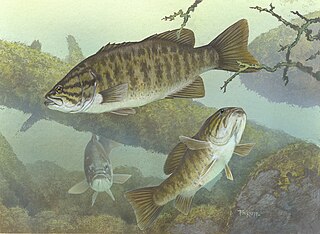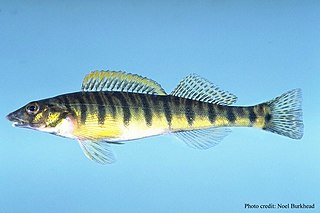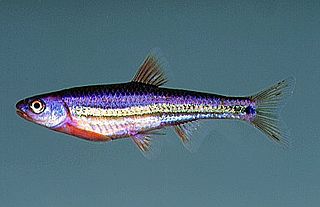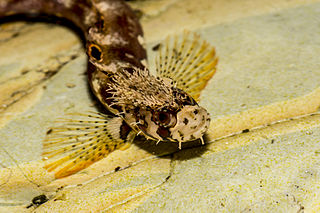
Micropterus is a genus of Freshwater fish in the sunfish family (Centrarchidae) of order Perciformes. The species of this genus are known as the black bass.

Labrisomids are small blennioids (blennies), percomorph marine fish belonging to the family Labrisomidae. Found mostly in the tropical Atlantic and Pacific Ocean, the family contains about 110 species in 15 genera.

The blennioid family Chaenopsidae includes the pike-blennies, tube-blennies, and flagblennies, all percomorph marine fish in the order Blenniiformes. The family is strictly tropical, ranging from North to South America. Members are also present in waters off Japan, Taiwan and Korea. Fourteen genera and 90 species are represented, the largest being the sarcastic fringehead, Neoclinus blanchardi, at 30 cm (12 in) in length; most are much smaller, and the group includes perhaps the smallest of all vertebrates, Acanthemblemaria paula, measuring just 1.3 cm (0.51 in) long as an adult.

Gambusia is a large genus of viviparous fish in the family Poeciliidae. Gambusia contains over 40 species, most of which are principally found in freshwater habitats, though some species may also be found in brackish or saltwater habitats. The type species is the Cuban gambusia, G. punctata. The greatest species richness is in Mexico, Texas, and the Greater Antilles, but species are also found elsewhere in the eastern and southern United States, the Bahamas, Central America, and Colombia. Gambusia species are often called topminnows, or simply gambusias; they are also known as mosquitofish, which, however, refers more specifically to two species, G. affinis and G. holbrooki, which are often introduced into ponds to eat mosquito larvae. As a consequence, they have been introduced widely outside their native range, and frequently become invasive, threatening local species. They are only occasionally kept in aquariums, due to their relative lack of color and the highly aggressive nature of the aforementioned mosquitofish species.

Percina is a genus of small freshwater ray-finned fish, classified within the subfamily Etheostomatinae, part of the family Percidae, which also contains the perches, ruffes and pikeperches from North America. Like the similar fishes in the genus Etheostoma, they are some species called "darters". More specifically, the genus as a whole is known as roughbelly darters, while certain species of Percina with a pattern of vertical bars on the flanks are called logperches.

Rasbora is a genus of fish in the family Cyprinidae. They are native to freshwater habitats in South and Southeast Asia, as well as southeast China. A single species, R. gerlachi, is only known from an old specimen that reputedly originated from Africa (Cameroon), but this locality is considered doubtful. They are small, up to 17 cm (6.7 in) long, although most species do not surpass 10 cm (4 in) and many have a dark horizontal stripe.

Notropis is a genus of freshwater fish in the family Cyprinidae. They are known commonly as eastern shiners. They are native to North America, and are the continent's second largest genus.

The rainwater killifish is a small silvery fish with yellow flashes and diamond shaped scales that is widespread from Cape Cod, Massachusetts, through to Tampico, Mexico. It is commonly found in large numbers in fresh to brackish estuarine environments. It feeds on tiny crustaceans, mosquito larvae, small worms, and mollusks. It can reach up to 62 mm.

Cirripectes is a large genus of combtooth blennies found throughout the Pacific and Indian oceans.
Stathmonotus is a genus of chaenopsid blennies found in the Pacific and Atlantic oceans.

Neoclinus bryope, is a species of chaenopsid blenny found around Japan and South Korea in the western Pacific ocean, and around California in the eastern Pacific. It can reach a maximum length of 8 centimetres (3.1 in) TL.
Neoclinus chihiroe is a species of chaenopsid blenny found around Japan, in the northwest Pacific ocean. It can reach a maximum length of 4.8 centimetres (1.9 in) SL.
Neoclinus lacunicola is a species of chaenopsid blenny found around Japan, in the northwest Pacific ocean. It can reach a maximum length of 6 centimetres (2.4 in) TL.
Neoclinus nudus is a species of chaenopsid blenny found in coral reefs around Okinawa Island, Japan, and Taiwan, in the northwest Pacific ocean. Males can reach a maximum length of 5.2 centimetres (2.0 in) SL, while females can reach a maximum length of 4.6 centimetres (1.8 in).
Neoclinus okazakii is a species of chaenopsid blenny found in rocky reefs around Japan, in the northwestern Pacific ocean. Males of this species can reach a maximum length of 6.2 centimetres (2.4 in) SL, while females can reach a maximum length of 4.5 centimetres (1.8 in).
Neoclinus stephensae, the Yellowfin fringehead, is a species of chaenopsid blenny found in the eastern Pacific ocean. It can reach a maximum length of 10 centimetres (3.9 in) TL. The specific name honours the collector of the type, the British-American conchologist Kate Stephens who was Curator of Mollusks and Marine Invertebrates at San Diego Natural History Museum and who was over 100 years old at the time the species was described.

Neoclinus toshimaensis is a species of chaenopsid blenny found in rocky reefs around Japan, in the northwest Pacific ocean. It can reach a maximum length of 7 centimetres (2.8 in) TL. This species feeds primarily on benthic algae and weeds.

Neoclinus uninotatus, the Onespot fringehead, is a species of chaenopsid blenny found in the eastern Pacific ocean. It can reach a maximum length of 25 centimetres (9.8 in) TL. This species feeds primarily on benthic crustaceans. It has been known to live for up to 7 years.
Siphateles is a genus of fish belonging to the family Cyprinidae, native to the Western United States. They were formerly placed in the genus Gila.

Kate Stephens was an American naturalist and the Curator of Mollusks and Marine Invertebrates at the San Diego Natural History Museum from 1910 to 1936.













